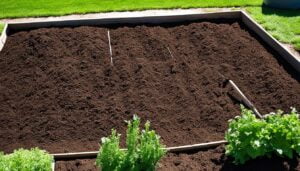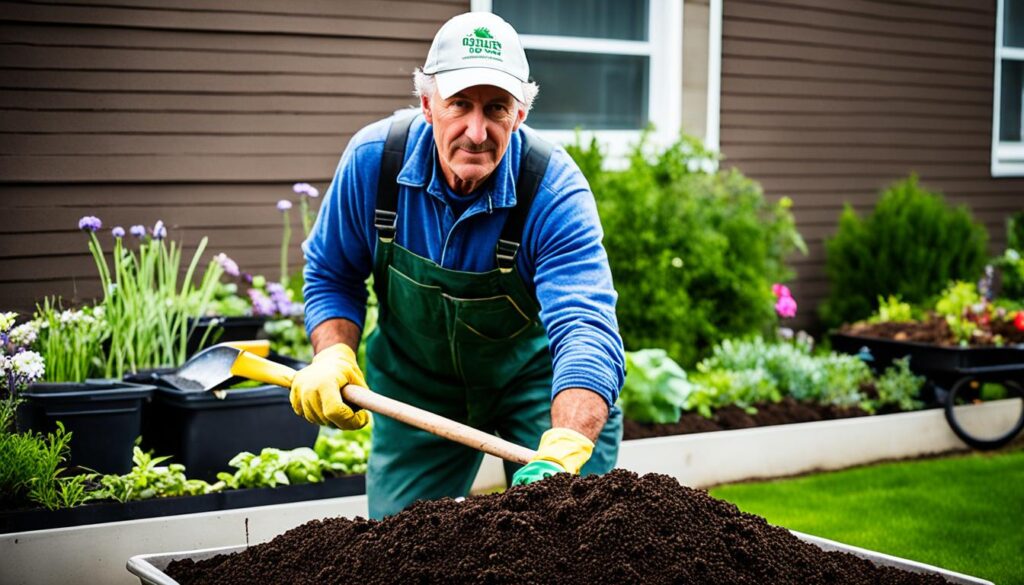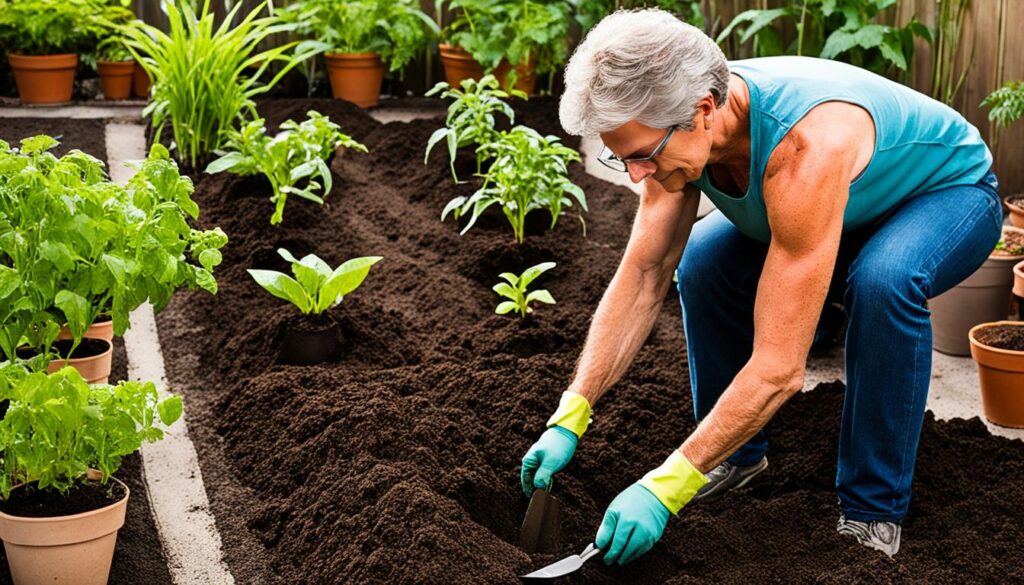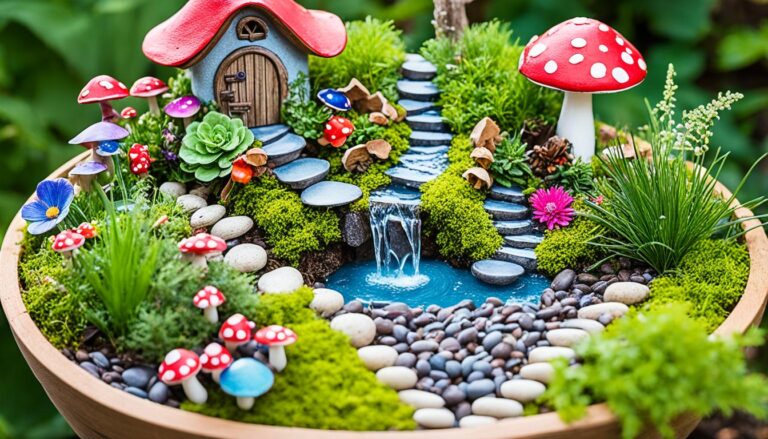Preparing Soil for Planting Getting the soil ready for planting is key to a great garden. It’s vital for plants to have rich, supportive soil. A healthy garden starts with the ground, which should be full of life. This includes tiny friends like bacteria, fungi, and earthworms.
These creatures help feed plants, add nitrogen to soil, and keep it airy. Here are some top tips for preparing the soil for a lively, sturdy garden that aids strong plant growth.
Knowing how to prepare soil for planting puts gardeners in control. This way, plants can get the water, air, and nutrients they need to thrive. Whether it’s a veggie plot, flower patch, or herb bed, giving the soil the right care makes your plants healthy and strong.
Key Takeaways
- Preparing Soil for Planting Assess your soil’s feel and looks to plan your garden well.
- Boost soil health with natural stuff like compost or old manure.
- Knowing your soil’s pH helps you meet your plants’ needs better.
- Preparing Soil for Planting Adding organics makes your soil better for plants.
- Mulch often to help the soil keep moisture and stay healthy.
- Stop the soil from getting hard and keep it airy so roots can grow well.
- Check your soil from time to time to know how it’s doing and keep it fertile.
Understanding the Composition of Soil
Gardening starts beneath the surface with the soil’s composition. Knowing how vital soil preparation is helps gardens grow well. Soil is not just dirt—it’s a mix that helps life flourish.
Defining Soil Structure
Soil structure is how the soil’s tiny bits of sand, silt, and clay are arranged. The best mix, loamy soil, holds water well but also drains. Yet, this can change a lot between gardens, affecting how well they keep water and nutrients. Gardeners tweak the soil’s structure with organic methods to help plants grow. Adding compost or manure can turn tough soil into fertile ground.
The Role of Living Organisms in Soil Health
Soil health depends a lot on life in it, like bacteria, fungi, and earthworms. These creatures break down waste, recycle nutrients, and support plants. The condition of this alive part is crucial for successful soil preparation.
Good practices like not tilling too much and using mulch help the soil’s life. It’s also about always learning to make the soil rich and alive. This supports a diverse and strong garden.
To sum up, knowing soil’s makeup and its living parts helps gardeners prep the soil well. By using soil preparation tips and organic soil preparation methods, they can have a solid base for healthy plants.
The Foundation of a Healthy Charles Garden: Soil Preparation Preparing Soil for Planting
To start a healthy Charles Garden, you must get the soil right. It’s crucial to know the difference between soil and dirt.
Recognizing the Difference Between Soil and Dirt
Real soil is full of life that helps plants grow. It has nutrients and tiny organisms. But dirt is dead, so plants don’t thrive in it. By improving the soil, we create a good place for plants to live.
Adding Organic Matter for Nutrient Density
Organic matter like compost is key for good soil. It’s packed with nutrients and helps friendly microbes live in the soil. This keeps the soil rich and strong, making plants healthy.
The Critical Practice of Mulching
Mulching is great for the soil. It keeps in moisture and protects from extreme temperatures. Mulch from leaves or straw feeds the soil as it breaks down. This method also safeguards the soil from damage.
Methods to Reduce Soil Compaction
Excessive tilling can harm the soil. No-dig gardening keeps the soil loose and moist, perfect for roots. Adding organic matter regularly stops the soil from getting too tight.
Following these steps is key to a great Charles Garden. Whether you’re starting a new bed or just topping off nutrients, every action helps. Mulching well supports all these efforts.
| Mulching Technique | Depth | Material | Duration |
|---|---|---|---|
| Initial Bed Preparation | 3-4 inches | Compost | Season-long |
| Winter Protection | 5-6 inches | Straw or Leaves | Over winter |
| Weed Suppression | 2 inches | Wood Chips | 4-6 months |
| Moisture Retention | 2-3 inches | Bark Mulch | Throughout growing season |
This table helps choose the best mulch and shows how long each type lasts. It’s a guide to keep the soil healthy for your garden to flourish.
Assessing Your Garden’s Soil Type
It’s key to know your garden’s soil well. This knowledge helps in deciding what plants to grow and how to get the soil ready. Soils can be sandy, silty, or clay. The best mix is loam, which has sand, silt, and clay in good balance.
A simple test can tell you a lot about your soil. By feeling the soil, you can find out what it needs for plants to grow well. Now, let’s see what’s important about each soil type:
| Soil Type | Texture | Common Characteristics | Suggested Preparations |
|---|---|---|---|
| Sandy | Gritty | Drains quickly, poor in nutrients | Adding organic matter to improve nutrient retention |
| Silty | Smooth | Retains water well, susceptible to compaction | Use of mulching and raised beds to avoid compaction |
| Clay | Sticky when wet, hard when dry | Rich in nutrients, poor drainage | Enhanced by adding sand and organic matter to improve drainage |
| Loam | Balance of sandy, silty, and clay | Ideal for most plants, excellent drainage and nutrient content | Maintaining balance by regular composting and adequate fertilization |
For better soil in your garden, start by knowing what you have. This helps picking the right plants and preparing the soil well. By checking soil type, you can choose the best ways to improve it. This might mean changing the pH, adding nutrients, or tweaking the texture. Knowing your soil’s nature is the first step to a blooming, healthy garden.
Preparing Soil for Planting Best Practices for Soil Preparation
Starting a garden can be greatly helped by knowing the best soil preparation methods. It focuses on making the soil better by adding compost, adjusting the pH, and avoiding mistakes in soil improvement.
The Fallacy of Mixing Sand and Clay
Some think that adding sand to clay improves the soil, but it’s not true. Doing this can make the soil too hard, harming plants. The best way is to use lots of organic matter, like compost.
Composting: A Cornerstone for Organic Soil Preparation
Turning food scraps and garden waste into compost is key for healthy soil. Compost boosts fertility and keeps the soil well-structured. It’s an essential step for preparing the soil organically.
Balancing Soil pH for Optimal Growth
Soil pH is critical for plant health, as it affects nutrient availability. Many crops do best in slightly acidic to neutral soil. Adding lime raises the pH, while sulfur lowers it. This improves nutrient intake and helps plants grow strong.
By focusing on these steps, you are creating an ideal environment for plants to thrive. It shows that the foundation for successful gardening is laid in good soil preparation. This is the heart of sustainable gardening.
Preparing Soil for Planting Guidelines for Soil Texture and Conditioning
Improving soil texture and soil conditioning for gardening is key to a thriving garden. Different soils need different care. For a garden to look good and stay healthy, you must know its type. This can be clay, sandy, or the dreamy loamy.
Clay soil is full of nutrients but often gets waterlogged. This is bad for plant roots. Sandy soil, on the other hand, drains well but can’t keep nutrients around. We aim for a loamy soil, which is perfect for many plants.
Add organic matter to the soil for better gardening results. Things like compost and aged manure improve soil both physically and chemically. They make the soil a happy place for plants.
- Compost: Adds nutrients and makes soil structure better.
- Aged Manure: Nutrient-rich and helps the soil hold water.
- Leaf Mold: Keeps moisture in and makes the soil nicer.
- Coconut Coir: Makes soil lighter by adding air and reducing heaviness.
| Soil Type | Texture | Common Issues | Recommended Amendments |
|---|---|---|---|
| Clay | Wet and sticky | Poor aeration and drainage | Compost, Leaf Mold |
| Sandy | Gritty | Quick drainage, nutrient leaching | Coconut Coir, Aged Manure |
| Loamy | Equal mix of sand, silt, clay | Occasionally dense | Compost, Plant Material |
To make plants grow best, keep the soil a bit acidic (between 6.0 and 6.5 pH). This helps plants get more nutrients. No matter what you’re growing, getting the soil’s pH right and using the right amendments helps. This creates a perfect space for your plants to thrive.
Preparing Soil for Planting with Nutrient Management
For a garden to be successful, managing nutrients for planting is key. It’s important to balance the soil’s nutrients. This helps the plants grow well and produce more. Also, adjusting the soil’s pH level can help plants use these nutrients better. This leads to ideal conditions for their growth.
Key Nutrients Needed for Robust Plant Growth
When it comes to garden plants, they need three main nutrients: nitrogen, phosphorus, and potassium. These are called NPK. Nitrogen is great for making green, leafy plants. Phosphorus helps with roots and flowers. And potassium makes plants overall healthier. It helps them fight off diseases and manage water. For the best results, it’s good to test your soil. This tells you what nutrients might be missing.
Nitrogen, Phosphorus, and Potassium: The Essential Trio
Different plants need different amounts of NPK. You can find fertilizers with specific mixes. For example, there’s 5-10-5 or 10-10-10. Choosing the right one gives every plant what it needs. It ensures they grow strong and healthy. It’s also important to regularly check and adjust these nutrient levels. This helps avoid giving plants too much fertilizer. Too much can harm them.
Amending Soil to Achieve Desired pH Levels
The soil’s pH level also affects how plants get their nutrients. Most garden plants like a slightly acidic to neutral environment. This means a pH of 5.8 to 6.8 is best. To keep the pH right, you might need to add lime or sulfur. Agricultural lime can adjust the pH for a long time. Pelletized lime is a quicker option but needs more often application.
A good garden starts with careful nutrient and pH management. By doing this right, gardeners can grow beautiful, lush plants. It shows how important it is to prepare the soil well.
How to Prepare Soil for Planting
Creating a lush garden starts with preparing the soil. It’s vital for both new garden areas and introducing new plants. You should remove rocks and loosen the soil for healthy root growth.
Adding organic matter is critical in the beginning. Compost and manure enrich the soil. They also make it better for plants. Tools like spades and rakes get the soil just right – not too wet or dry.
- Loosening the soil for improved aeration
- Incorporating organic material to boost nutrient content and soil texture
- Adjusting soil as per specific plant needs for optimal growth
Choosing the right fertilizer is also key. It’s matched to both the soil and the plants. This step promotes garden health for the long run.
Test the soil’s fertility by checking its N, P, and K levels. This is important for plant growth.
Every soil type needs different care. Loamy soil is great as-is, but clay and sand need work. Amend the soil to suit the plants you’ll grow.
Keep an eye on the soil’s pH level, which is vital for plant health. Most vegetables prefer a pH of 6.0 to 7.0. Adjust it with lime or sulfur if needed, but remember, it takes time.
By preparing the soil well, gardeners create a perfect space for plants to flourish. It’s all about setting the right foundation for your garden.
Organic Methods for Improving Soil Fertility
Improving soil fertility with organic methods boosts the earth for healthy plants. This supports not only the soil but also its living world.
Using Compost for Soil Enrichment
Using compost helps gardens a lot. It makes the soil better. It keeps moisture in and adds nutrients. You can find more details here.
The Benefits of Aged Manure
Aged manure is key for better soil organically. It gives plants slow nutrients and keeps the soil airy and moist.
Choosing the Right Soil Amendments
Picking the right soil help is important. Each choice, be it plant stuff or coir, makes the ground better. The selection depends on your soil and what plants need.
Choosing the right kind of help for your soil does a lot. It boosts soil health and plant growth. Plus, it’s good for the earth’s balance.
| Nutrient | Found in Compost | Found in Manure |
|---|---|---|
| Nitrogen | Yes | High |
| Phosphorus | Moderate | High |
| Potassium | Yes | High |
| Microbial Activity | High | High |
Using compost and manure boosts the soil’s natural power. This keeps plants healthy and the garden thriving. It’s a win for you and nature.
Maintaining Soil Health Through the Seasons
For gardeners, the shift between different growing seasons means it’s crucial to care for the soil. They use various methods like raised bed gardening and cover crops to help. These efforts ensure the garden stays healthy all year.
Raising Beds for Improved Drainage and Aeration
Raised beds make a big difference in how well water and air move through the soil. They keep the soil lifted, avoiding compaction and making roots happier. This approach also keeps the soil warm, which extends the time plants can grow.
Cover Crop Strategies for Sustainable Soil Health
Cover crops, including legumes and grains, are great for the soil. They add nutrients, prevent soil from washing away, and attract helpful nitrogen. This not only makes the soil better for future crops but also fights off weeds and pests naturally.
Regulating Water and Nutrient Uptake with Mulching
Mulch plays a big role in keeping the right amount of moisture and temperature in the soil. When it’s from things like straw or wood chips, it also breaks down and feeds the soil. Mulching cuts down on weeds, helping plants get the water and nutrients they need.
| Technique | Benefits | Considerations |
|---|---|---|
| Raised Bed Gardening | Improved drainage and aeration, extended growing seasons, reduced soil compaction | Initial setup cost and effort, requires more frequent watering |
| Cover Crops | Soil fertility enhancement, erosion prevention, natural pest management | Selection based on climate and soil type, requires timely sowing and removal |
| Mulching | Moisture retention, temperature control, nutrient recycling | Choice of material, thickness of application, timing of refreshment |
Conclusion
Preparing Soil for Planting Starting a successful garden is all about what’s below the surface. It begins with checking the soil’s pH balance and adding compost. These choices help make sure our gardens can thrive for years to come.
We take great care to protect the earth when we garden. We manage water well to avoid problems like waterlogging. Cover crops and well-designed water systems protect the soil and help it stay healthy. Using raised beds can also lead to healthier plants because it improves the soil and drainage.
Sustainable gardening means doing a lot of different things right. Adding nutrients to the soil, managing water well, and preventing erosion are key. These efforts make our gardens and the earth better for everyone. It’s about growing plants well and caring for our world at the same time.













